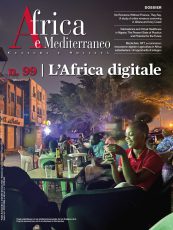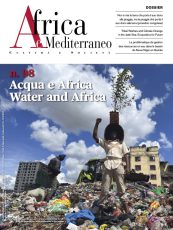Sulla restituzione | On Restitution
Africa e Mediterraneo n. 100 (1/24)
This issue of Africa e Mediterraneo journal gathers ideas and conversations on the topic of restitution, opening up transdisciplinary discussions around cultural policy and especially ethics, and urging a rethinking not only of the objects and their histories of origin, but also of how the international museums that house these objects should proceed, addressing both their practices and concerns. The contributions invite us to reexamine the genealogy of institutions, classifications, and the meanings of works and artifacts. More radically, they question dispositifs like the Museum, built from modernity onwards, the mindset behind his creation, and the Eurocentric coloniality that informs them to this day, and which persists in every social and political stance on the relationship between the West and post-colonial cultures, between white and non-white citizens.
The central issue examined in this collection of essays is how to respond to the desire of African-origin communities to reclaim what was taken from them. The topic of restitution has recently gained worldwide attention, as Western institutions, which hold objects with unclear provenance and grappling with a history that is challenging to preserve, have expressed a need to shed the weight of colonial heritage and distance themselves from the label of “last avatars of colonialism”. The quest for historical truth has spurred numerous research projects and intense collaborations between researchers in dispossessed nations and those in possessing countries, as well as negotiations between former capitals and former colonies. However, the needs of white institutions should be secondary, and the debate should finally focus on the human, emotional, and existential needs of the communities who have been robbed, through studies that rehabilitate (or at last narrate through non-Western epistemologies) the human significance of these artifacts.
In the West, we ask ourselves how to proceed from a legal and institutional perspective, or we focus on the historical aspect, asking: what epistemologies and political tensions gave rise to the Colonial Museum? Some voices—informed by open academic practices that view artistic research as a non-disciplinary epistemic space for proposing models to complicate history—turn to historical reconstruction that sheds light, for example, on private collections of artifacts that arrived in Europe from the Renaissance onward.
What do these often unaddressed histories reveal about the construction of a paradigm of African devaluation that begun a hundred years after the transatlantic slave trade? If colonialism’s asymmetric cultural relations led to the looting of cultural objects, how did we construct colonial frameworks? How do they still function today? How should we deconstruct our gaze to denaturalize these frameworks and their impact on our contemporary societies? How can we make up for it?
Above all, however, we must listen to the looted communities. Colonization inhibited African cultural heritage, severing communities from communion with their ancestors and forcing colonized peoples, deprived of their culture, to adopt superficially assimilated Western cultural values to fill a void. The debate on restitution, reconstitution, and repair through the reclamation of cultural values helps to reconnect the precolonial past, consciously buried and forgotten, to an amputated postcolonial present. The rehabilitation of traditional cultural practices should drive a cultural renewal, a resurrection of violated precolonial healing the dysfunctions that have emerged between communities of origin and their environments.
Restitution would put an end to wars that have been tearing various tribes apart and restore community unity: communities of origin would regain their dignity, identity, and authenticity, as well as their cultural personality, scorned by history. What is being returned? What is the value of cultural artifacts restored to communities of origin? These questions underpin a debate that should mirror that of Western societies and engage the so-called modern African continent, among the members of communities of origin, to foster dialogue and awareness of the importance of African cultural values in general and their maintenance and preservation.
Restoring all destroyed traditional values seems to be the answer to the questions: “What is the future of our mother tongues, especially within intellectual families? How do we maintain our cemeteries? How do we preserve our archival documents?” These questions expose our attitudes towards the cultural values of the continent, helping to assess the importance and legitimacy of the cultural artifacts returned or yet to be returned, and of the repatriation of human remains to African populations.
Cover: Unknown author, Uhum welao 73.1997.14.1, Nigeria – Culture Edo, between XV century and XVI century, brass. Musée du Quai Branly. Photo by Sailko
Africa e Mediterraneo n. 100 (1/24); Lingua: Contiene articoli in italiano, inglese e francese; Codice ISSN: 1121-8495; Formato: 120 pp., 21×28 cm, brossura filo refe.
ABSTRACT







